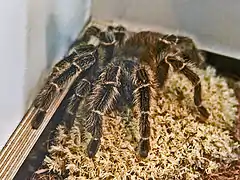| Lasiodora difficilis | |
|---|---|
 | |
| Lasiodora difficilis | |
| Scientific classification | |
| Domain: | Eukaryota |
| Kingdom: | Animalia |
| Phylum: | Arthropoda |
| Subphylum: | Chelicerata |
| Class: | Arachnida |
| Order: | Araneae |
| Infraorder: | Mygalomorphae |
| Family: | Theraphosidae |
| Genus: | Lasiodora |
| Species: | L. difficilis |
| Binomial name | |
| Lasiodora difficilis Mello-Leitão, 1921[1] | |
Lasiodora difficilis, common name Brazilian red birdeater, is a species of tarantulas belonging to the family Theraphosidae.[2]
Distribution
This species is native to Brazil.[3]
Habitat
These tarantulas live in rainforests characterized by a wet tropical climate with little or no dry season and abundant rainfall.[3]
Behavior
These spiders take refuge in a long hole or under roots or stones. They feed on insects, worms, grasshoppers and crickets.[4] The egg sac may contain 500-1000 spiderlings.[5]
Description
Lasiodora difficilis can reach a body length of 9 centimetres (3.5 in), with a leg span of seven to eight inches.[3] Males are smaller than female.[5] The basic color of these heavy-bodied spiders varies between black and black-gray, with urticating red hairs on the abdomen.
References
- ↑ "Taxon details Lasiodora difficilis Mello-Leitão, 1921", World Spider Catalog, Natural History Museum Bern, retrieved 2016-03-26
- ↑ de Mello-Leitao, C.F. (1921), "On the genus Lasiodora, C. Koch.", Annals and Magazine of Natural History, 9 (8): 337–350, retrieved 2016-03-26
- 1 2 3 Basic tarantula
- ↑ Exotic animals
- 1 2 DC Tarantulas
This article is issued from Wikipedia. The text is licensed under Creative Commons - Attribution - Sharealike. Additional terms may apply for the media files.